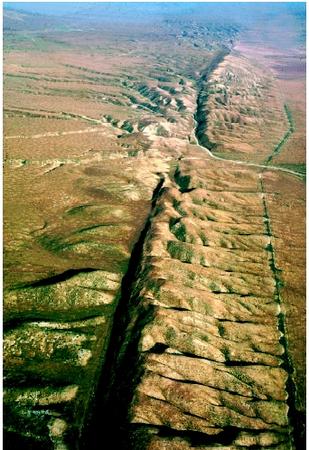Groundwater Pumping Increasing Seismic Activity
Published on May 27th, 2014
Is the combined weight of 38 million Californians actually deforming the Earth’s crust and increasing the number of earthquakes as well as causing the Coast Range and Sierras to soar even higher?
This may sound more like the premise of a satirical piece in The Onion or an absurd article in the tabloid National Enquirer rather than the thrust of a recent research paper in the respected British scientific journal Nature.
The paper in Nature is “Uplift and seismicity driven by groundwater depletion in central California” and it was written by geologists from Western Washington University, the University of Ottawa, the University of Nevada-Reno and the University of California-Berkeley.
Granted, the research is not claiming the combined weight per se of 38 million Californians is directly causing an uptick in earthquake frequency, but in a very real sense, the new research indirectly connects the increasing aggregate human load on the environment to increased seismic activity.
|
|
|
Groundwater pump in Central Valley – contributing to more earthquakes? |
How? The mechanism – or culprit – is excessive withdrawal of groundwater.
The findings indicate that accelerated pumping of groundwater from California’s Central Valley may be increasing the elevation of the Coast Range and Sierra Nevada as well as the number of earthquakes along the San Andreas Fault.
 |
|
The San Andreas Fault |
Groundwater use in California’s San Joaquin Valley (the southern portion of the Central Valley) substantially exceeds recharge of the aquifer. Indeed, the cumulative amount of water removed since pumping began is 38 cubic miles (158 km3), enough to help cause the disappearance of the late, great Tulare Lake, once the largest body of fresh water west of the Mississippi River. The other cause was the diversion of Tulare Lake’s tributary rivers to agricultural irrigation and municipal uses.
The discrepancy between groundwater withdrawals and replenishment has only widened as a result of increased pumping during the blistering drought now punishing California. The drought has reduced surface water deliveries from the California Aqueduct and Delta-Mendota Canal, reliant on shrunken and shriveled supplies of Sierra snowmelt.
Over-pumping has led to a significant decrease in the groundwater resource and a rapid subsidence – sinking – of the San Joaquin Valley floor.
|
|
|
Pouring on the pressure (but alleviating seismic pressure) |
The sheer volume of groundwater withdrawal during the past 150 years also represents a substantial reduction of mass and “unburdening” of the lithosphere, that is, a lessened load weighing down the rocks that make up the Earth’s crust.
One consequence is that Earth’s crust is springing upward.
The geologists investigated the hypothesis that this load reduction might produce potential impacts on crustal deformation and seismicity. They used vertical global positioning system (GPS) measurements to show that a broad zone of unexpectedly swift (at least in geologic timeframes) rock uplift surrounds the southern San Joaquin Valley.
The study results further suggest that uplift of the Coast Ranges reduces stress on the San Andreas Fault, which in turn pushes the fault closer to failure, thereby providing a viable mechanism for the observed seasonal variation of microseismicity (small earthquakes).
In addition, the study authors inferred that the observed simultaneous uplift of the southern Sierra Nevada, which was previously attributed to tectonic forces (i.e., plate tectonics or “continental drift”) is actually a result of human-caused groundwater depletion, at least in part.
Lead author Colin Amos told the L.A. Times:
Over the long term, because we’re losing more groundwater, it could give rise to more seismicity by reducing these overall forces….humans may have a hand in changing the state of stress on the fault, and therefore, rates of small earthquakes over time.
Paul Lundgren, a geophysicist at NASA’s Jet Propulsion Laboratory (JPL) in Pasadena, told The Guardian:
The human effect is becoming the dominant effect. The more you deplete that groundwater, the more you keep promoting that fault towards failure.
Amos also clarified for the Times that:
Large earthquakes are going to occur on the San Andreas Fault no matter what we do.
Be that as it may, this latest research demonstrates yet again the extent to which we Homo sapiens have become a geologic force in our own right, agents of the newly named “Anthropocene Age.” While we may be the authors of this new geologic age, we may also eventually be among its most prominent casualties.






